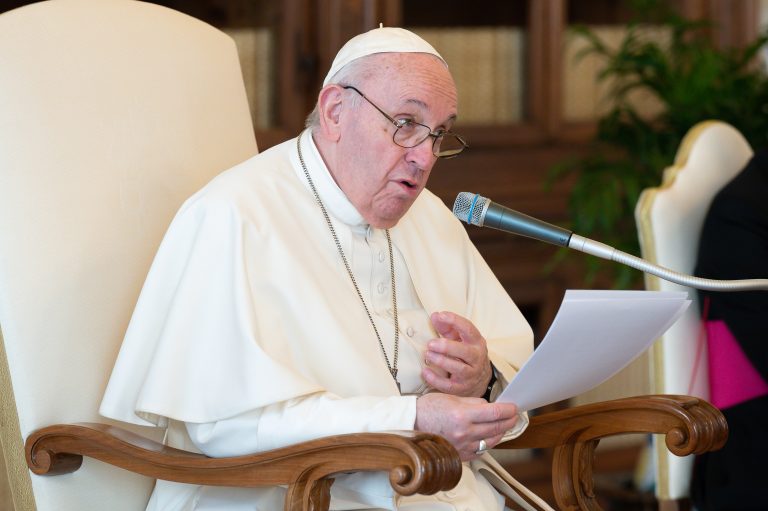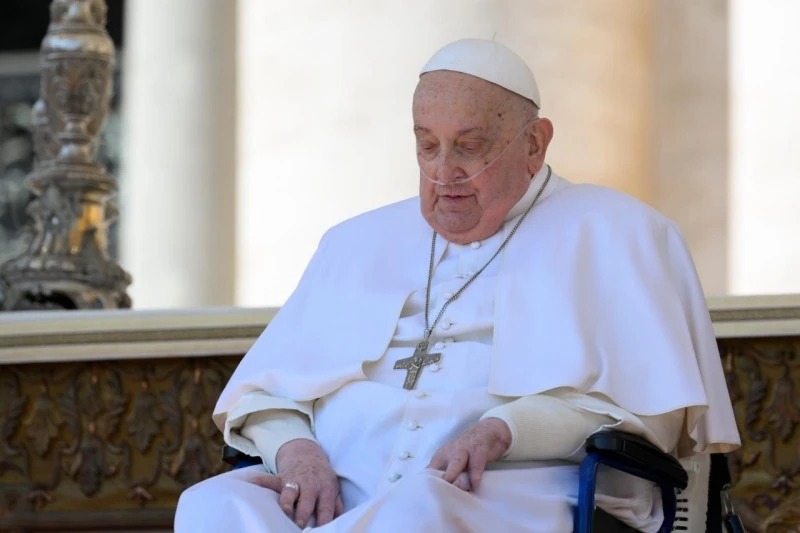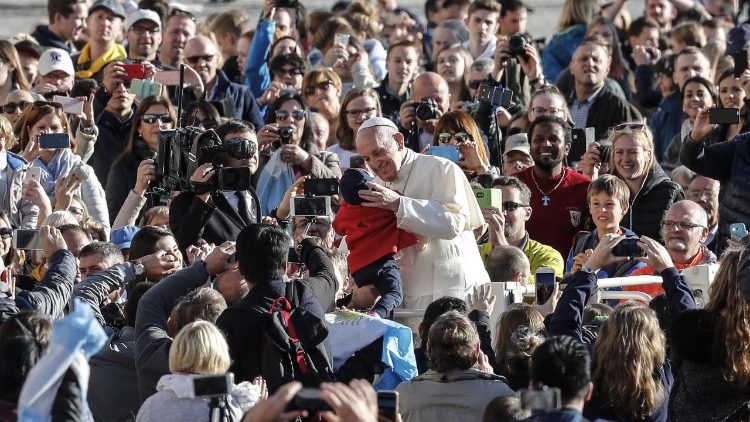Prayerfully Recollecting Amid Busy Days – Pope’s Full General Audience
Catechesis on Prayer, Focusing on Meditation

Amid our busy days, we need to take moments to prayerfully recollect. Pope Francis gave this reminder during his private General Audience today, April 28, on prayer, which was streamed again from the Pope’s apostolic library.
This comes as Italy after having remained in partial lockdown, as the country continues to battle this most recent wave of the coronavirus and its variants, has begun to lift some restrictions this week.
Continuing his series of catecheses on Christian prayer, this week he focused on meditative prayer.
Aim Is for Relationship With Him to Grow
“Everyone needs moments of recollection amid the busyness of our daily lives,” the Pope highlighted, noting that for Christians, meditation “is not simply a matter of introspection” but “a method of prayer, a means of encountering Christ, above all in the mysteries of his earthly life.”
Even if there are many methods of meditation in the Church’s rich spiritual tradition, the Pontiff observed, he acknowledged they all have a single aim: “to enable us to grow in our relationship with Jesus our Savior.”
“By the grace of the Holy Spirit, our union with Christ in faith is nurtured through the use of our intellect, imagination, emotions and desires. The Catechism, the Jesuit Pope reminded, teaches that meditation on the mysteries of Christ deepens our faith, prompts the conversion of our hearts, and strengthens our will to follow in his footsteps.
“Our Lord’s every word and action,” the Holy Father reminded, “can thus touch us and become a part of our own lives.”
Invited to Encounter Christ Constantly
“On every page of the Gospel we are invited to encounter Christ and to discover in him the source of our salvation and our true happiness.”
Cordially greeting the English-speaking faithful, the Pope said: “In the joy of the Risen Christ, I invoke upon you and your families the loving mercy of God our Father. May the Lord bless you all!”
Below is the full text of Pope Francis’ General Audience. The full English translation of the Pope’s pronounced words was provided by the Vatican:
***
Catechesis on prayer: 31. The meditation
Dear brothers and sisters, good morning!
Today we will talk about the form of prayer called meditation. For a Christian, to “meditate” is to seek meaning: it implies placing oneself before the immense page of Revelation to try to make it our own, assuming it completely. And the Christian, after having welcomed the Word of God, does not keep it closed up within him or herself, because that Word must be met with “another book”, which the Catechism calls “the book of life” (cf. Catechism of the Catholic Church, 2706). This is what we try to do every time we meditate on the Word.
The practice of meditation has received a great deal of attention in recent years. It is not only Christians who talk about it: the practice of meditation exists in almost all the world’s religions. But it is also a widespread activity among people who do not have a religious view of life. We all need to meditate, to reflect, to discover ourselves, it is a human dynamic. Especially in the voracious western world, people seek meditation because it represents a high barrier against the daily stress and emptiness that is everywhere. Here, then, is the image of young people and adults sitting in meditation, in silence, with eyes half-closed… But what do these people do, we might ask? They meditate. It is a phenomenon to be looked on favourably: in fact, we are not made to run all the time, we have an inner life that cannot always be neglected. Meditating is therefore a need for everyone. Meditating, so to say, is like stopping and taking a breath in life. To stop and be still.
But we realise that this word, once accepted in a Christian context, takes on a uniqueness that must not be eradicated. Meditating is a necessary human dimension, but meditating in the Christian context – we Christians – goes further: it is a dimension that must not be eradicated. The great door through which the prayer of a baptised person passes – let us remind ourselves once again – is Jesus Christ. For the Christian, meditation enters through the door of Jesus Christ. The practice of meditation also follows this path. And the Christian, when he or she prays, does not aspire to full self-transparency, does not seek the deepest centre of the ego. This is legitimate, but the Christian seeks something else. The prayer of the Christian is first of all an encounter with the Other, with a capital “O”: the transcendent encounter with God. If an experience of prayer gives us inner peace, or self-mastery, or clarity about the path to take, these results are, one might say, consequences of the grace of Christian prayer, which is the encounter with Jesus. That is, meditating means going – guided by a phrase from the Scripture, from a word – to the encounter with Jesus within us.
Throughout history, the term “meditation” has had various meanings. Even within Christianity it refers to different spiritual experiences. Nevertheless, some common lines can be traced, and in this we are helped again by the Catechism, which says, the Catechism says: “There are as many and varied methods of meditation as there are spiritual masters. […] But a method is only a guide; the important thing is to advance, with the Holy Spirit, along the one way of prayer: Christ Jesus” (n. 2707). And here it indicates a travelling companion, one who guides: the Holy Spirit. Christian meditation is not possible without the Holy Spirit. It is he who guides us to the encounter with Jesus. Jesus said to us, “I will send you the Holy Spirit. He will teach you and will explain to you. He will teach you and explain to you”. And in meditation too, he is the guide for going forward in our encounter with Jesus Christ.
Thus, there are many methods of Christian meditation: some are very simple, others more detailed; some accentuate the intellectual dimension of the person, others the affective and emotional dimension instead. They are methods. All of them are important and all of them are worthy of practice, inasmuch as they can help. What do they help? The experience of faith to become an integral act of the person: a person does not pray only with the mind; the entire person prays, the person in his or her entirety, just as one does not pray only with one’s feelings. No, everything. The ancients used to say that the part of the body that prays is the heart, and thus they explained that the whole person, starting from the centre – the heart – enters into a relationship with God, not just a few faculties. This is how the ancients explained it. This is why it must always be remembered that the method is a path, not a goal: any method of prayer, if it is to be Christian, is part of that sequela Christi that is the essence of our faith. The methods of meditation are paths to travel to arrive at the encounter with Jesus, but if you stop on the road, and just look at the path, you will never find Jesus. You will make a “god” out of the path. The “god” is not waiting for you there, it is Jesus who awaits you. And the path is there to take you to Jesus. The Catechism specifies: “Meditation engages thought, imagination, emotion and desire. This mobilisation of the faculties is necessary in order to deepen our convictions of faith, prompt the conversion of our heart, and strengthen our will to follow Christ. Christian prayer tries above all to meditate on the mysteries of Christ” (n. 2708).
Here, then, the grace of Christian prayer is: Christ is not far away, but is always in a relationship with us. There is no aspect of his divine-human person that cannot become a place of salvation and happiness for us. Every moment of Jesus’ earthly life, through the grace of prayer, can become immediate to us, thanks to the Holy Spirit, the guide. But, you know, one cannot pray without the guidance of the Holy Spirit. It is he who guides us! And thanks to the Holy Spirit, we too are present at the river Jordan when Jesus immerses himself to receive baptism. We too are guests at the wedding at Cana, when Jesus gives the best wine for the happiness of the couple, that is, it is the Holy Spirit who connects us with these mysteries of the life of Christ because in contemplation of Jesus we experience prayer, to join us more closely to him. We too are astonished onlookers at the thousands of healings performed by the Master. We take the Gospel, and meditate on those mysteries in the Gospel, and the Spirit guides us to being present there. And in prayer – when we pray – we are all like the cleansed leper, the blind Bartimaeus who regains his sight, Lazarus who comes out of the tomb… We too are healed by prayer just as the blind Bartimaeus, the other one, the leper… We too rise again, as Lazarus rose again, because prayer of meditation guided by the Holy Spirit leads us to relive these mysteries of the life of Christ and to encounter Christ, and to say, with the blind man, “Lord, have pity on me! Have pity on me!” – “And what do you want?” – “To see, to enter into that dialogue”. And Christian meditation, led by the Spirit, leads us to this dialogue with Jesus. There is no page of the Gospel in which there is no place for us. For us Christians, meditating is a way of coming into contact with Jesus. And in this way, only in this way, we discover ourselves. And this is not a withdrawal into ourselves, no, no: it means going to Jesus, and from Jesus, discovering ourselves, healed, risen, strong by the grace of Jesus. And encountering Jesus, the Saviour of all, myself included. And this, thanks to the guidance of the Holy Spirit. Thank you.
[Vatican-provided text]
[Original language: Italian]
Related

Pope Francis’ Catechesis: God always comes to find us!
Exaudi Staff
17 April, 2025
5 min

Pope Francis’ Catechesis: The Rich Man. Jesus “Looked at Him with Love”
Exaudi Staff
09 April, 2025
4 min

Pope Francis and Hope: Reflection on Jesus’ Encounter with Zacchaeus
Exaudi Staff
02 April, 2025
2 min

“God is mercy and always awaits us!”
Exaudi Staff
26 March, 2025
3 min
 (EN)
(EN)
 (ES)
(ES)
 (IT)
(IT)

